Entries Tagged as 'Museums'
“Slavery, The Scale of Freedom” by Owen. “These scales show how hard it was and can be to achieve liberty and justice when fighting for freedom” reads the sign. The scale, the representation of inequality frightens me.
An introductory passage in the museum describes the need for us to restrain from using historical terms such as “Negro” and “Mulatto” which were derogatory terms during slavery. I think back to the time when in I resided in Azerbaijan, my college-educated parents and friends would refer to anyone who is of a mixed ethnicity as a “mulatto” which now I know is originated from the word “mule.” And when African American men in United States refer to each other as “Negros” in a “joking” manner. Or when the abolition of slavery in East Indies occurred, the government found a new source of cheap labor in India resulting with 1,500,000 Indians being subjected to the system. Reading novels such as Saalam:Brick Lane, West Indian and South Asian communities are still feeling the effects of abuse put upon them by those who were in a place of power.
Upon visiting the atlantic transatlantic slavery exhibition questions arose: Is freedom truly achieved in England and around the world? Are the facts presented at Docklands Museum part of the past or present (as in certain actions by those in power limit actions of those who have less power)? If my liberal, educated family used a derogatory term “Mullato” and did not even realize how much hurt it held behind it, how do we further educate on the topic of slavery and how much more there is behind it?
With the mixed reviews posted by the museum visitors at the end of the exhibition, I couldn’t help but question the British education system. With the comments ranging from acceptance and understanding to guilt and criticism, I wonder how comfortable the British are with their history and how much they discuss in their secondary school regarding the British participation in transatlantic slavery.
It frightens me that without education, dialogue, and willingness to change and accept the cycle will continue and a new group and culture will suffer from injustice. Words such as “Mullato” and “Negro” will be spoken and “Scales of Freedom” will never reach a balance.


Tags: Jeyla · Museums
August 25th, 2009 · 1 Comment
As I sit and write this blog post, I am listening to Claire De Lune by Debussy.
How beautiful it is, that music has the ability to bring people together, regardless of race, religion, or nationality. During the concert today, I became very fascinated with the ability to believe something to be universal. How can such a large group of people enter a Christian church, in no means looking for religion, to attend a performance by an unknown group, that solely relies on ones ability to hear. Can such an art form unite human beings? Do we have the knowledge to accept the fact that people of this world have more in common than we think, or are we too busy promoting our differences? Is peace a possibility in our future? I’m not sure, however I do believe that music is a beautiful representation of how people of the world can connect no matter the differences.
I feel like I say this every time I write a blog, but how could my day start any better. I absolutely loved watching E.L.F perform. Their first piece, which was an abridged version of the Broadway Musical “Phantom of the Opera”, was one of the most moving experiences I have had here in London. To be in such a historical building, and to watch these passionate individuals perform, was truly a beautiful site.
After the performance I headed towards the National Gallery Museum. Not only did I about wet my pants at the size of the museum, but as I walked further towards the entrance the view from its steps became more and more beautiful. Many of London’s great land marks were right in front of my eyes. “Unbelievable” is the only word i can use to describe what I saw. The Museum was what I expected and more. I have a particular interest in Rembrandt and other Dutch artists, and i think it is because of my obsession with early modern Europe. Rembrandt painted during the 16th century when Holland was a very important economic country. It is a wonderful example of how Europe was evolving over the 15th-18th centuries but still remained a central area for the arts. I really enjoyed this museum. I made it through many of the galleries but I would love to go back and spend more time in each section.
It was a wonderful day. I wake up every morning in shock that I’m lucky enough to be here. I hope every step I take reflects how grateful I am to be here. I LOVE IT!
Tags: Museums · Patsy
Today’s class centered around a discussion of how immigrant and minority populations in London have either struggled or been able to assimilate. We examined specific groups and religions and attempted to define exactly what assimilation entails. Kelley brought up a great point about how some groups that come to London have no interest in assimilation. They come simply to get an education, make some money and share what they’ve learned once they return to their country of birth. This complicates the assimilation process even more. What can we do as educated young people to help minority groups achieve assimilation? Do they want our help at all? These are some questions I am going to continue to wrestle with for the remainder of my time in the U.K.
After class today I had an afternoon filled with art, both musical and visual. A lunchtime concert at historic St. Martin in the Fields featured a fantastic three man ensemble called E.L.F. Made up of a pianist Geoff Eales, french horn player Dave Lee and flautist Andy Findon the group put on an incredible performance highlighted by an extraordinary 40 minute take on Andrew Lloyd Webber’s “The Phantom of the Opera”. The music was moving and captivating throughout and at the end of “All I Ask of You” I was left with goosebumps from head to toe. As someone who played trumpet and a little bit of French Horn throughout high school I was amazed by the richness of the sound Mr. Lee produced. It was superior to anything I had ever heard performed in the past. The church’s incredible acoustics certainly had a major impact on the groups resounding sound as well turning a three man ensemble into what sounded like a full fledged orchestra. One action that took place during the concert that Brandon and I were pondering was whether it is customary for performers to exit the stage completely while the audience applauds and then return for the next number shortly after. We were unsure if this was something unique to England, unique to St. Martins in the Fields or whether the group chose to do so at their own discretion. In any event it was something we had never seen before.
After the concert Aidan, Brandon and I headed over to the National Gallery where we gazed at thousands of works of art from all different countries and time periods. I do not know much about visual art and what techniques are used to make paintings considered great but I was continually amazed and impressed by the amount of detail these artists put into their work. Even the smallest stroke of a paintbrush can change a painting entirely. We spent a number of hours inside the National Gallery gazing at everything from Van Gogh to Manet to Van Brugh. Visual art is not my forte nor my specialty but I was very impressed and would go back to the museum in a heartbeat.
After our tour of the National Gallery we headed back out to Trafalgar Square. The rain had let up and the square was alive with all kinds of people. There was protesting, dancing, singing and any number of exciting things going on. We took an abundance of pictures while in the area, attempting to catch all the excitement that was taking place as well as capturing the various monuments in the area such as Nelson’s Column and St. Martin in the Fields.
The final stop in our afternoon included a tour of the National Portrait Gallery, just down the road from St. Martin in the Fields. Inside we viewed portraits of everyone from Princess Diana to T.S. Eliot. My favorite part of the portrait gallery was the section they featured on the Bloomsbury Group. Portraits of Virginia Woolf, E.M. Forster and Lytton Strachey just to name a few were found inside this area. After going on the Bloomsbury walk the day before with Professor Qualls the information was still fresh in my mind and I was able to make connections between the tour and the exhibit. This was fascinating.
I can safely say that this has been my favorite day in London so far. A stimulating discussion, an unbelievable concert, a walk through an internationally recognized museum and time spent with friends adds up to a wonderful and busy day. I hope that the rest of our time spent in London will follow suit.
Tags: Churches and Cathedrals · Henry · Museums
August 24th, 2009 · 1 Comment
Yesterday, we took a walking tour around Bloomsbury, the neighborhood that is adjacent to our own. Learning about the area was truly fascinating, and I felt so lucky to have the opportunity to see where Virginia Woolf lived, walk along the sidewalk where Charles Darwin might have walked, and experience an area that is so rich in history.
We learned that in this one small area lived; Charles Dickens, The Bonham Carters, Edgar Allan Poe, Ralph Waldo Emerson, Thomas Hodgkin, Henry James, Charles Darwin, Virginia Woolf and T.S. Eliot. In fact, we saw a building that once housed the publishing company where T.S. Eliot worked, and were told of how his wife – whom Eliot claimed was mentally unwell – would “picket” outside the building with a sign that read “I am the abused wife of T.S. Eliot!”
We walked though an area around Russell square which was destroyed during the Blitz and rebuilt years later. It was interesting, too, to see just how severe the destruction of the city was at the Docklands Museum today. The rest of the museum was very informational, as well. I particularly enjoyed the sections about the docklands themselves. Being a visual learner, I found it very useful to see all the diagrams, primary sources of life at the Docklands and other visual and kinesthetic aids that connected with our readings. In particular, I remember one of the articles mentioning how dangerous working at the docks was; how many men were killed by falling into the storage areas below deck or suffering other serious injuries. After seeing some of the chains, hooks, and other tools used by the workers, I can really see just how dangerous working on the docks was.
Attached are some pictures both of the Bloomsbury walk and the Docklands Museum…
Tags: Anya · Museums
Being an individual who thrives on organization and cohesiveness I have been very pleased with how everything in this course is beginning to connect. On Sunday I was part of the Docklands group that went through the museum and saw the African slavery/triangle trade exhibit. Viewing the exhibit was a very moving and captivating experience and I was very pleased to see it brought up today as part of our discussion. We have been given ample opportunities to take what we have seen on our adventures outside the classroom these past few days and bring them into our formal class discussions and today we took advantage of that opportunity. In my perfect world this is what all learning should be like. From learning through each others blog posts/thoughts in class we will not understand everything about London but we will get a greater understanding of London than if we were all charged to study everything about the place. Receiving information in small concentrated doses has been a great way for me to really focus on one subject at a time and absorb that material. I hope that continues.
On a completely different note, Aidan, Brandon and I went on a wonderful walk around the Thames on Saturday night. We took the Underground from Goodge street to Embankment and walked around that area for a bit. During our stroll we saw a lot of people dressed up in eclectic garb, singing, dancing and gyrating. One of the most entertaining moments of the night was when a group of five women dressed in matching skimpy maid outfits climbed on a boat and headed down the river. Four of the women were in their 20’s and one was about 60. One thing i’ve noticed here is that People here don’t seem to care much about age differences when it comes to social life. In the five days i’ve been here I’ve seen people from vastly different generations laughing together at pubs, sharing personal stories in a park and walking hand in hand. Regardless of their age everyone seemed excited about the weekend and the prospects of a good Saturday night. The streets were packed and it was hard to move more than five feet without bumping into someone. Overall we sensed embankment to be a fairly touristy area with many American style/fast food restaurants lining the streets.
After our walk uptown we headed down to the waterfront where we made our way across the Thames by way of the Hungerford bridge. While walking over the bridge we got some fantastic pictures of the London Eye. When we finally reached the other side of the bridge we took some time to observe the variety of buskers/street performers lining the streets. While observing a jam band I was nearly “roundhouse kicked” in the face by a man who was either very intoxicated or was missing a few marbles. At this point I decided that I had heard enough of the jam band and moved on to observe a magician locking himself in a suitcase and a man break-dancing with a bicycle helmet on. Both were very talented and entertaining. I like that London requires these buskers to receive licenses in order to display their acts. This ensures that only the cream of the crop are given the chance to perform . From my own brief busking experience back in high school I know all too well that not every busker is worthy of the limelight.
After hanging around County Hall for a while we decided to head back across the Thames. We completed the loop and took Westminster Bridge back just as the sun was setting, snapping some fantastic photos of Parliament, Big Ben, County Hall and the London Eye. After walking back to Embankment We got back on the Northern Line and headed to Leicester square where we decided to grab dinner at “The Spaghetti House”. Despite the overall quality of the food we decided we would probably not go back again. The reasoning behind this decision was twofold. The first reason was the food was a bit too expensive for its quality and the second was we had two waitresses taking care of us. The latter may sound like a good thing but neither waitress knew that the other one had us covered. This simply created confusion and left us with multiple bills at the end of the night.
From this walk I took a couple things that will stick with me. I became better oriented with the waterfront and the monuments that are set around it. I also learned about both the Westminster and Hungerford Bridge and would love to learn more about the history of bridges over the Thames. Another thing that stuck with me was the vibrant personalities I experienced during our walk. Between the street performers, the eclectic characters we saw in the streets and the man that almost knocked me out with his shoe I quickly learned that London has such a variety of personalities and life experiences to offer. There is an amazing cast of characters that lives within this city. We have now become a part of that cast as well. The million dollar question is where exactly do we fit into London’s present plot both as Americans, as young people and as students? This is something I will continue to explore during the rest of my time here.
Tags: Henry · Museums
…it’ll take you to the most unexpected places. These past two days have been extremely informative and exciting; provocative and shocking; and most of all, eyeopening. This past Sunday, as we all gathered together to take a trip back in time to the founding of Londinium, I found myself thinking about the people who walked this same land thousands of years ago. We tend to think about the older civilizations as fairly one dimensional; as a group of warriors that fight to defend their land. In fact, most of the history classes that I have taken really emphasize the importance of ancient battles, using them as markers in the timeline of the civilization’s evolution. But really, this only leaves us gaps in our knowledge, just like the gaps in the timeline. I guess ultimately, I find myself feeling unfulfilled by this sort of approach to history. What about the people, what about their fears and hopes, what about their humanity? These questions have always run through my head throughout my various history classes, yet since I have been in London, I have been pleasently surprised thus far.
We have walked the streets, learning and interacting with the history that surrounds us. I have really enjoyed seeing where influencial people have lived, walking the street where the Great Fire started…essentially being able to visualize life, to compare it to my own, to recognize their hardships and their successes.
This was especially evident on Sunday when my group headed to the Docklands to visit the museum. We were all stunned into silence as we quietly wandered from room to room which powerfully exposed the ugly truth about slavery in England. We read letters and journal entries illustrating the pain of the enslaved, we saw paintings describing the horrors, we saw the chains that bound them and held them in captivity. Basically, we saw, heard, and touched the brutality of the slave trade in London’s early history and were able to witness that same prejudice manifest itself in today’s society. This very racism was clearly seen in the comments folder that was kept inside the museum. This folder held a variety of comments; some appreciated and loved the museum for its accurate portrayal of the events that have evolved into the current lingering prejudices that plague London, as well as comments that expressed downright contempt for the museum. One I clearly remember saying, “this place is a piece of crap and i ain’t coming back”. Though the grammatical errors make this person’s comment particularly ridiculous, it shocks and angers me to see that people like this still stubbornly refuse to grasp the reality that is present. Here I was finally being able to see some kind of progress as to how we approach learning history, and yet simultaneously here was some ignorant asshole willing to skip over the potentially difficult, but nevertheless REAL, facets of English history! After this experience, my group rallied together to discuss our reactions, all of us mirroring one another’s disgust. I have to say that the comments in that little binder really struck me and I have been thinking about them ever since we left…It’s funny how one person’s bad comment can really impact an experience. With the walking tour that took place today, however, I am feeling a lot better and and again excited that we took the past and made it our present.
Tags: Maddie · Museums · Uncategorized
What I love about our walking tours is the complete sensory overload that occurs when we set off up and down the streets. Of course, the visual stimuli are wonderful, The Roman Wall, the Tower of London … I could go on and on. But the great thing is that it’s not just visuals. On market day I was able to indulge in the delicate spices wafting through the air from the many food vendors at Acton Market. Also, this entire journey has been made even more enjoyable by the wide selection of tastes I have enjoyed… Wensleydale cheese, Aloo Kachori, Sheppard’s Pie. Yesterday on my Bloomsbury tour I was able to hear some different sounds than I was used to. When we walked past Coram’s Fields I heard the laughter of children and the whooshing of a zip-line inside the playground. This was the complete opposite the church bells pealing and the traffic rushing by that I heard on the Roman Wall tour earlier that morning. The tube is another story altogether. The Brits who ride the underground are silent…. Another one of their “privacy rules” I’ve noticed. If people are talking it’s in another language or it’s one of my classmates. Listening to other languages as I wander around has really made me appreciate London as a global city. Where else can you walk down a side street and hear one man talking in rapid Portuguese on his mobile and hear a woman speaking to her daughter in Farsi within two blocks of each other? My trip out to West India Quay this afternoon only increased my interest in the sounds of this great city.
The Docklands Museum provides a wonderful time line of life by the Thames from pre-Londinium to the present day. In considering London the ultimate melting pot of humanity, this museum manages to incorporate many of the major events of the Docklands history in its three floors. I enjoyed many of the interactive aspects of the museum such as the touch screen information panels, the dark sailor’s alleyway (thanks for going first Brandon!), and the spice boxes. However what really struck me were the audio aids. At every exhibit you were bombarded with snippets of sounds that perfectly blended with the content of the prompts and the visuals. Like many of my classmates, the exhibit on the evolution of slavery in England made a major impact on me. The audio and video that accompanied this section was powerful, arresting and disturbing. I can tell you that the words will stay with me for a long time. As I walked around reading about the Middle Passage, Caribbean plantations and the struggle for Abolition, “YOU WILL BE BEATEN, YOUR CHILDREN WILL BE TAKEN AWAY FROM YOU, YOU WILL LOSE YOUR FREEDOM” kept ringing in my ears. Once I reached the exhibit on the London Blitz, the whispered and paranoid tones of “ Keep it under your hat” and “Loose lips sink ships” had me looking over my shoulder to make sure I was alone.
Take each small moment and observe what is going on around you. At lunch I heard opera music drifting into the back garden, I heard the fire alarm 20 minuets ago, A dog is barking outside right now. Each day I spend here gives me another opportunity to “listen in” and lean about the city of London. I encourage everyone to look up when you walk around, open your window, sit out in the garden, go to a park or a pub.
I read this poem at The Docklands Museum and it immediately made me think of this course.
“The London Breed” by Benjamin Zephaniash (1996)
‘I Love this great polluted place
Where pop stars come to live their dreams
Here ravers come for drum and bass
And politicians plan their schemes,
The music of the world is here
This city can play any song
They come to here form everywhere
Tis they that made this city strong.
A World of food displayed on streets
Where all the world can come a dine
On meals that end with bitter sweets
And cultures melt and intertwine
Two hundred languages give voice
To fifteen thousand changing years
And all religions can rejoice
With exiled soul and pioneers
It’s so cool when the heat is on
And when it’s cool it’s wicked
We just keep melting into one
Just like the tribes before us did
I love this concrete jungle still
With all its sirens and its speed
The people here united will
Create a kind of London breed.’
Tags: Grace · Museums

Today I was apart of the group that went to the Dockland Museum and finally got to experience what everyone had been raving about yesterday. Like Azul, I had taken the Museum Studies class last semester and put together an exhibit on co-education this summer, so I can no longer look at museums or exhibits without using a critical eye. Hands down, the London, Sugar, & Slavery exhibit was the best I have ever seen. The task and challenge of the curator to take on a subject that is not particularly easy or pleasant was a feat in itself. And the exhibit was absolutely spectacular.
After reading the lists of ships and passengers at the exhibit’s entrance, I was moved by this satirical painting that followed those disturbing lists. The painting was called May Morning by John Collett, 1765, and showed a crowd of people of different ranks and statuses, all white except for one African man in the center of the painting. At first when I looked at the painting, I though it was interesting that, for the 1700s, the African man was the focal point of the picture and was not standing out in any obnoxious way but just blending in. Then I read the description of the painting and found out that it was meant to be a satire. I also noticed that all of the other people had lighter clothes on and were highlighted, while the African man was in the back and dimmed. I found it interesting that this painting could have been viewed in two completely different lights depending on the knowledge known about it beforehand.
 (sorry it’s blurry, couldn’t use flash).
(sorry it’s blurry, couldn’t use flash).
About halfway through the exhbit I came upon the sight of beautiful china, teacups and saucers and pots. Any other time I would have been delighted at the sight, because I love old teacups and such. But after going through the horrors of the exhibit and seeing the suffering the enslaved Africans had to go through, the sight of these cups full out disgusted me. I knew that people who had no idea of the pain of these people who worked to give them sugar for their tea. I was talking to Audrey, who was viewing the artifacts next to me and she had the same reaction. It is strange how an object that I usually think of as beautiful could be so cruel and disgusting to me.

One of the best points of the exhibit that actually happened in the beginning and resounded in my head while I browsed the exhibit was the words, “This is your history” from the video. I thought it was quite bold, but much needed, of the museum to place those lines simply, but powerfully, at the end of this very moving video. To me, it was like a cold slap in the face, and I believe it was for many other people to, to make them realize that yes this is our history and we have to come to terms with it. Once we accept, learn about it, we can finally move past it, instead of trying to brush this brutal history aside.
This exhibit completely moved me almost to tears. I learned so much from it and was glad to read that a majority of the comment cards were positive about it as well. I hope someday in the near, near future we can all move past pretending the bad parts of our history don’t exist.
Tags: Alli · Museums
Following another group’s visit to the Docklands, I had the advantage of advice. Based on their stories of their experiences, I knew to pay close attention to the part of the museum that focused on London’s role in the history of slave trade. The advice proved true as that was possibly the most interesting parts of the museum. Interesting only begins to describe the section, however. Nothing could have prepared me for the emotions the exhibit hit on. Opening with a list of numbers of people that were traded as commodities, the exhibit never ceased to be emotionally gripping as it portrayed the cruelty that came out of such trade. The photographs, video clips, personal accounts- everything on display made the reality of this blemish on all our histories keenly felt. The exhibit ended, for me at least, with a feeling of hope. Hope that we have learned that people are to be treated as just that- people. Hope that such mistakes will never be repeated.

Empire Windrush
Just a floor below this part of the exhibit, this hope was shaken quite a bit. Mixed in with videos of pretend interviews with the leaders of the dock strikes and boxes of exotic spices to smell, a small posting stands unassuming amongst the rest of the other relatively unimportant/of moderate importance posts. This posting mentions Windrush. As I have just visited Brixton, I knew the name to be an important one. Windrush had been a ship used just after World War II to bring Caribbean migrants over to England (advertised as “the home land” or “the Mother Country”) for the purpose of those migrants to work on the docks. To the world, this transportation of immigrants was advertised as a ‘multiculturalization’ (my word, but I think it works here) of England.

Arrivals off the Windrush
Let me start of by saying that yes, I recognize that this is in no way slavery. These immigrants were asked to come to London through job postings, they made the decision to come over, and were offered jobs, houses, and lives of their own once they arrived. But I cannot shake the feeling that there are striking parallels (or at least common threads) between these two acts. Firstly, referring to England as the Mother Country only harkens back to their days of imperialism. It would be difficult to convince me otherwise. Secondly, asking those from a country that has at any time been a colony to come to your country for the sole purpose of providing cheap labor and enticing them to come with the promise of cheap transportation seems to me like asking them to come and assume the role of someone just one step over what a slave might have been. Then to claim that this is the beginning of a multicultural society is an act that just seems ludicrous to me. Yes, these immigrants settled in community of Brixton which does bring diversity to London but to claim that this was the intent of the invitation to come to the country seems (again, this is a personal feelings) less than honorable. So while Windrush Square is in the process of being built as a community center in Brixton, I wonder if the community should feel such a strong connection to the name. Maybe using the word “should” is a bit vague. But I wonder why the name is used. Is it really honoring the community or placing a reminder of one’s place in society? Maybe I’m reading too much into things. But I’m not convinced that that’s the case. I would argue that if Brixton wanted a community center, it could be named the Brixton Community Center and no one would demand that the name have any more historical value. Again, maybe I’m wrong. I guess the hope is that I am.
Tags: Audrey · Museums
August 23rd, 2009 · 1 Comment
From the minute we moved into the “London, Sugar, and Slavery” section of the Docklands Museum I think we all knew it was going to be something different; something unlike other things we typically see when at a museum. Being a very visual person I was immediately drawn to a video that began as we entered the area. The film was the reading of a diary of an enslaved African (as the Dockland Museum’s terminology sign stated it would refer to slaves as). Images of different people mouthing the words of his diary flashed across the screen along with other scenic and touristy images of London, as a man’s voice spoke it and the words of the entry scrolled along the bottom. The letter ended with the final words, “someday I hope this will all end, and we will all be free.” I simple wish of a man who could do nothing besides hope for the best in the future.
Keeping that video in mind I strolled through the remainder of the exhibit reading the signs and refreshing my memory of what I have learned about slavery in the past. But when I got to the end of the exhibit I immediately stopped in my tracks. The final wall in this area as entitled “Loss & Liberty” and featured modern ceramic artwork paired with poetry.
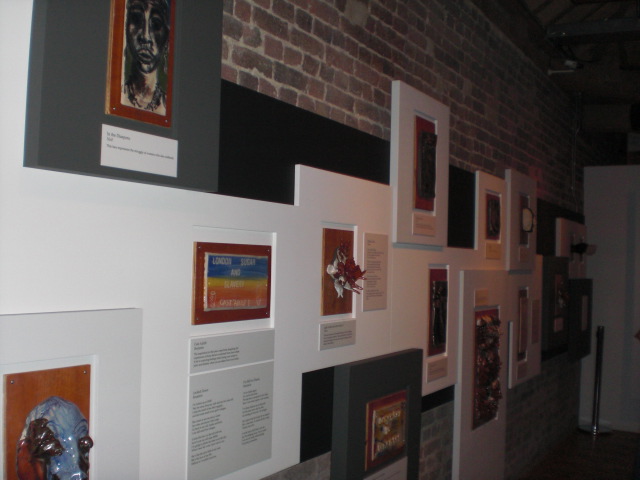
Loss & Liberty
I moved through the artwork and poems slowly, taking in each one as it came. The Caribbean rose, the faces of strained men and women, and the repetition of these images returned my thoughts to the video from the beginning of the exhibit. The repeated modern images and the eloquent words of the enslaved African from the past, paralleled with the ceramics and the words of current men who have experienced, have heard, or are experiencing similar thoughts and feelings as the man did writing in his diary in the 1700s. At that moment the exhibit all came together for me in a world of history, art, and culture all uniting, blurring, and mixing– into one.
To read more about my time in London/UEA and to see more pictures visit: http://amandaepower.blogspot.com/
Tags: Amanda · Museums





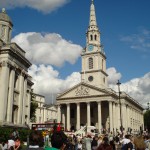

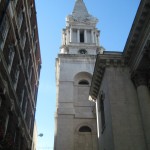
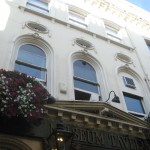
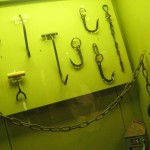

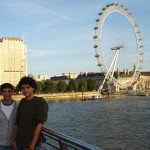

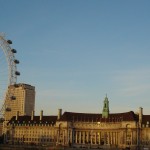
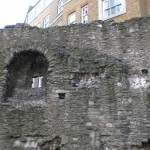
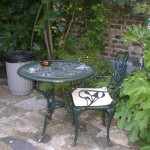
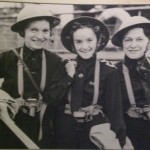

 (sorry it’s blurry, couldn’t use flash).
(sorry it’s blurry, couldn’t use flash).

